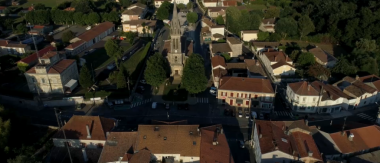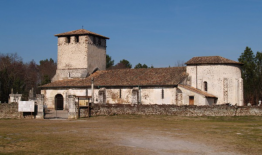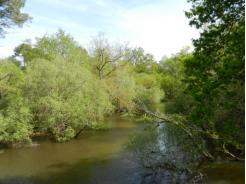Belin-Béliet, Gironde, Nouvelle-Aquitaine 作者: 来源: 发布时间:2021-01-13
I. Population and Area
Total Area: 156, 03 km2 (60.23 sq mi)
Population in 2017: 5 529
Population Density: 35 /km2 (92 /sq mi)
II. Natural Geography (environment and resources)

Belin-Béliet is a commune in the urban area of Bordeaux located in the Landes de Gascogne Regional Natural Park in the south-east of the Pays de Buch in the Landes forest, 45 km south of Bordeaux.
Belin-Béliet is a commune in south-western France, located in the Gironde department, in the Nouvelle-Aquitaine region.
The neighboring municipalities are Le Barp to the north, Saint-Magne to the northeast, Hostens to the east, Mano to the southeast, Moustey to the south, Saugnacq-et-Muret to the southwest - the last three municipalities being in the Landes department -, Lugos to the west and Salles to the northwest.
Communication channels: the municipal territory is crossed by important communication routes.
1. two North / South lanes which correspond to the historic axis of the Way of St. James: the A63 motorway and the Departmental Route 1010 (former RN10).
2. two East / West lanes: Departmental Route 3 and Departmental Route 110.
3. the cycle path connecting the Arcachon Bay to the Bazadais.
Transport:
1. Carpooling for your leisure or home-work trips: With Trans’Gironde Carpool, carpool easily ... The Arcachon Basin - Val de l'Eyre territory joins forces with the Gironde Department to offer you a space for networking.
2. Regular bus lines: Bus service to BORDEAUX or BASSIN D’ARCACHON.
Website: transgironde.gironde.fr/horaires/ (especially for lines n ° 505, 5051 and 610).
3. Train: the nearest SNCF train station: Facture-Biganos at 25 km.
Hydrography: the village is crossed by Eyre (or Leyre).
III. GDP
Employment income (%): 80.7 (2016)
Poverty rate by age group of the tax advisor(%): 10 (2017)
Average employment income (€):2 331 net per month (27 967 net per year)(2014)
IV. Industrial Characterisitics
Major private employers:
1. Beynel Manustock, manufacturer of wooden or aluminum pallets, sawmill:
PGS BEYNEL, a simplified joint-stock company with a single partner, has been active for 29 years.
Located in SALLES (33770), it specializes in the sector of manufacturing wooden packaging. Its workforce is between 100 and 199 employees.
In 2018, it generated sales of € 40,635,400.00.
The balance sheet total decreased by 4.08% between 2017 and 2018.
Societe.com lists 7 establishments and the last notable event of this company dates from 11-10-2018.
PALETTES GESTION SERVICES is president of PGS BEYNEL.
2. Domaine du Preuilh, producer of carrots in particular:
SCEA DOMAINE DU PREUILH, civil society of agricultural exploitation civil society of agricultural exploitation has been in activity for 27 years.
Located in CHARTRES (28000), it specializes in the sector of cultivation of cereals (except rice), legumes and oilseeds.
Societe.com lists 4 establishments and the last notable event of this company dates from 14-01-2015.
BSF AUDIT is statutory auditor of the company SCEA DOMAINE DU PREUILH.
Company is in the process of liquidation.
Budget: find here the major budget complexes of the municipality of Belin-Béliet and various downloadable documents.
1. Budget key figures:
Operating section: € 4,828,962
Investment section: € 5,165,636.48
+ € 491,272.18 in cash flow
2. Debt: € 729 per capita
Capital remaining due on January 1, 2018: € 3,714,275
V. Attractions
Église Saint-Pierre de Mons (Saint-Pierre church of Mons)

l The Saint-Pierre church is located in Mons, a place in the commune of Belin-Béliet in the French department of Gironde. Mons is located on the departmental road D110E1, which links Belin-Béliet to Lugos.
It was built in blocks of ferruginous sandstone (alios or garluche), it has a Romanesque apse dated from the 11th century with a series of six carved capitals, a nave lined to the south of a collateral and finally an important, long tower at the end of the 15th century responding to defensive concerns as evidenced by the organization of its higher level.
The surroundings of this monument reveal the miraculous fountain of Saint-Clair, an ancient stone cross in the cemetery and a mysterious obelisk.
Mons and its church occupy a special place in the region, located on an ancient north-south route which led to Spain (ancient route then pilgrimage route to Santiago de Compostela).
Ancient texts tell us that the companions of Roland de Roncevaux would be buried there. A priory was installed there which was reformed in 1497. It controlled a good part of the Leyre Middle and its catchment area up to Hostens. Texts dating from the end of the 15th century (royalties) tell us about their homes and what they cultivated.
The original 11th century church with its defensive bell tower dates from the late 15th century and reflects the defensive concerns raised by the Hundred Years War.
2. La Leyre

Our town is crossed by the Leyre, formed by the confluence at Moustey (Landes) of the Grande Leyre and the Petite Leyre.
It flows in a South-South East, North-North West direction.
The Grande Leyre flows over 60km and the small Leyre over 50 km, they take their sources in the department of Landes, respectively in the Hautes Landes of South East, between Captieux and Morcenx for one and at the level of the commune of Luxey for the other.
After the confluence, the Leyre enters the Gironde for 40 km to end up with a delta in the ARCACHON Basin.
The catchment area of this river is 215,000 ha.
The Leyre has dug its valley to the sands, gravels and clays of the Pliocene.
3. La Forêt d'Art Contemporain : couleurs, oeuvre n°18 (The Forest of Contemporary Art: colors, work n °18)

Colors, Philippe Fangeaux. Le Barp, 2017. Programming: Jean-Francois Dumont.
"Colors" is an unusual project which consists in taking advantage of a landscape with the arrangement of four blocks of colors. Those who are curious to go online to find out about the artist’s work will see a period of his work called "Retouches". Landscape paintings on which the artist painted with brushes or rollers more or less geometric shapes that come in part to pick up or stretch, or even be at the initiative of the representation that is on the canvas. Numerous examples in art history show us painters who are also powerful sculptors, starting with prehistoric painters who knew how to draw profile from the shape of the rocks on which they traced, or even Michelangelo.
4. Parc naturel régional des Landes de Gascogne (Landes de Gascogne Regional Natural Park)

Breathe. In front of you, as far as the eye can see, stretches the pine and heather forest bathed in sunlight. You are at the heart of the Landes de Gascogne Regional Natural Park; 336,100 hectares of nature.
Here, we practice a gentle, streak-free, peaceful hike. And we stay with hosts who respect their environment. The 100% relaxation and nature holiday guarantee.
VI. History
Origins: various finds made in the Great Moor have shown that during recent prehistory and protohistory our territory was not a great desert.
Origin of the name: ss for the origin of the name Belin (Beliet being a diminutive of "Belin"), it could be Roman (name of a character) or even linked to a Gallic god named belenos. Finding the origin of Belin in the name of a Gallic tribe (belendi) now seems to be excluded.
Eleanor's mound:
If overall the history of BELIN-BELIET is that of the surrounding country, it nevertheless presents particularities.
The highlights of Belgian history are, on the one hand, linked to the history of the Belin Castle and, on the other hand, linked to the passage through the communal territory of pilgrims from Santiago de Compostela.
Quickly the presence of a castle is attested in Belin.
From the Middle Ages this site seems to have had a certain notoriety, the songs of Geste are there to demonstrate it in particular Garin le Loherain whose companion is none other than Bégon de Belin. It is in Belin’s castle that a tenacious local tradition gave birth to Eleanor of Aquitaine, who was both Queen of France and Queen of England.
Anyway Aliénor granted the inhabitants of Belin and its jurisdiction an advantageous charter.
At this time it is possible that Eleanor owned the castle in his own right.
One thing is certain, however: Belin received the kings of England on several occasions during campaigns related to the Hundred Years War. Henri III so stayed there several times: in 1232 he dated important letters patent from Belin, on May 27, 1243 he was still in Belin, on July 15, 1243 he ordered all the barons of the country to be in Belin on the 1st Thursday of August, well armed and well mounted for military service. Finally on August 22 of the same year 1243 Henri III is still present in BELIN where he receives the homage of the Landes lords. Other kings of England also passed through Belin: Prince Edward on May 8, 1255, Edward 1st on June 7, 1288 and Edward III in 1343.
The lords of Belin succeeded each other until the revolution when the lordship disappeared and the castle was gradually dismantled. The last tower thus disappeared during the second half of the 19th century.
At the present time, only an evocative site remains with part of its clod which dominates the village of Belin. This place is known locally as the "hillock of Eleanor".
The two parishes
If the lordship of Belin included Béliet, it was not the same at the parish level.
Belin name of the castle and chief town of a jurisdiction was located on the territory of the parish of Mons belonging to the diocese of BAZAS.
From the seat of this parish still exists the district of Mons and its magnificent church, the oldest part of which dates back to the 11th century.
The parish of Béliet depended on the diocese of BORDEAUX.
Fusion: the municipalities of Belin and Béliet become the municipality of Belin-Béliet:
Under various laws and texts on mergers and groupings of municipalities and following the concurring deliberations of municipal councils on May 22, 1974 for Béliet and May 24, 1974 for Belin, a referendum was held on June 30, 1974 to consult the inhabitants of two municipalities on the project to merge their two territories.
The positive result of this referendum led the Prefect of Gironde to sign, on August 7, 1974, the decree fixing the merger of the two municipalities into one: BELIN-BELIET.
In addition to the name of the new town, this decree fixes the chief town in the old town of Belin, indicates that the property and rights of the old towns are vested in the new town and fixes its entry into force on September 1, 1974.
VII. Other information
Natural heritage:
AN ECODESTINATION BY NATURE! Constituting a project territory federated around the values of sustainable tourism, the Ecodestination brings together 6 communities of municipalities and 5 tourist offices in its territory and neighboring territories.
Cultural Heritage :
From Romanesque to contemporary art, cultural heritage is an integral part of the territory. From the 11th century to the 21st century, sites full of stories that the Val de l'Eyre will tell you. Let yourself be surprised by this heritage.
IN THE COUNTRY OF ALIEN OF AQUITAINE AND CHARLEMAGNE! Legend or truth a tenacious local tradition makes the Château de Belin, the Château d'Aliénor!
If the birth of Eleanor of Aquitaine in Belin-Beliet is not a 100% proven fact, the presence of the castle is. Located on the motte castrale at the end of rue de hell in Belin, this castle stood out as a beautiful building dominating the medieval landscape of the time.
Forest: a forest mainly composed of maritime pines:
The area of the commune of BELIN-BELIET is 15,603 ha 27a 90ca of which 73% is forest.
The communal forest property covers an area of 302 hectares.
On the plateau, maritime pine is the only species represented in the forest. The Landes de Gascogne have for centuries been made of swamps even if the forest has always existed. In the 18th century, peasants from Landes created ditches and roads to clean up the region and prevent progress in the land of sands on the Landes coast.
In the 19th century, the law of 1857, enacted by Napoleon III, finalized the operation by ordering the municipalities to drain the land and plant pine trees.
Although it is an impressive area, the maritime pine forest of the Landes, essentially private, is therefore not natural but cultivated, extended over the centuries by man for the exploitation of wood.
On the other hand, in the valley of La Leyre the variety of the essences is very important with a dominance of pedunculate oak but one also meets the glutinous alder, the willow marsault, the chestnut, the tauzin oak, the ash, the small-leaved lime , aspen, hazel, plane tree more or less abundant depending on the state of waterlogging.
On the Camino de Santiago de Compostela, the Val de l'Eyre can boast a strong local history. Each of the five municipalities offers a range of sites to visit which, each in their own way, are worth seeing.
A simple pleasure and at the right pace to discover as closely as possible this pretty preserved corner of the Gironde Landes: the Val de l'Eyre! Find our routes to appreciate the forest massif!
VIII. Contact information
Belin-Béliet town hall address :
Mairie de Belin-Béliet
29 avenue Aliénor
33830 Belin-Béliet
Mayor : Marie-Christine Lemonnier (Mandate : 2014-2020)
Phone number: 05 56 88 00 06
Fax: 05 56 88 01 25
Mail: mairie@belin-beliet.fr
Website : http://www.belin-beliet.fr
